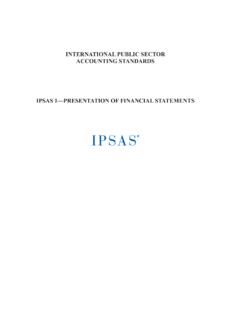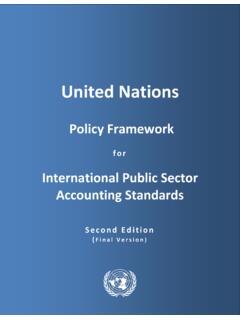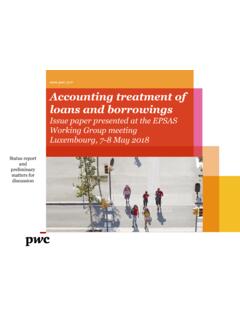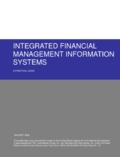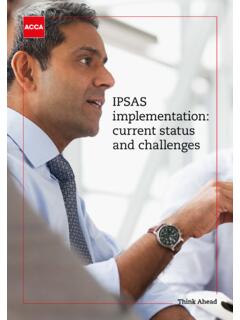Transcription of Newsletter A4 Single
1 Software-as-a-Service arrangements Connecting you with accounting changes from an era of digital transformation There has been an evolution in the technological architecture of entities across New Zealand. This has resulted in potentially significant accounting changes for entities that have entered into cloud-computing arrangements. Accounting alert MAY 2021 Accounting alert 02 The IFRS Interpretations Committee (IFRIC ) has published two agenda decisions clarifying how arrangements in respect of a specific part of cloud technology, Software-as-a-Service (SaaS), should be accounted for. The agenda decisions do not address the accounting for other components of cloud technology such as Infrastructure-as-a-Service and Platform-as-a-Service The first agenda decision, published in March 2019, concludes that SaaS arrangements are likely to be service arrangements, rather than intangible or leased assets. This is because the customer typically only has a right to receive future access to the supplier s software running on the supplier s cloud infrastructure and therefore the supplier controls the intellectual property (IP) of the underlying software code The second agenda decision, published in April 2021, deals with specific circumstances in relation to configuration and customisation costs incurred in implementing SaaS: In limited circumstances, certain configuration and customisation activities undertaken in implementing SaaS arrangements may give rise to a separate asset where the customer controls the IP of the underlying software code.
2 For example, the development of bridging modules to existing on-premise systems or bespoke additional software capability In all other instances, configuration and customisation costs will be an operating expense. They are generally recognised in profit or loss as the customisation and configuration services are performed or, in certain circumstances, over the SaaS contract term when access to the cloud application software is provided This conclusion could result in a reduction in profit in a particular year, impacting measures such as earnings before interest and tax (EBIT), earnings before interest, tax, depreciation and amortisation (EBITDA) and profit before tax (PBT) Where a change in accounting policy is required, comparative financial information should be retrospectively restated to derecognise previously capitalised costs, where material, in accordance with NZ IAS 8 Accounting Policies, Changes in Accounting Estimates and Errors There may be several consequential impacts beyond the immediate accounting implications arising from the IFRIC agenda decisions that should be considered, the impact on business metrics and targets linked to profit measures.
3 Although specific to for-profit entities, public benefit entities (PBEs) should also consider the implications of the agenda decisions for their SaaS arrangements. The first agenda decision as to whether the arrangement meets the definition of an intangible or a service is directly relevant since the PBE standard is based on the IASB s standard and has consistent definitions. The second agenda decision is also relevant in determining whether there is an asset or an expense and when to recognise the expense (when the service is delivered). Introduction Recent years has seen a particularly sharp increase in the number of New Zealand entities embarking on digital transformation projects, many of which incur significant upfront implementation costs. In March 2019, the IFRIC considered the accounting for SaaS arrangements (the first agenda decision) and concluded that for many such arrangements the substance is that the entity has contracted to receive services rather than the acquisition (or lease) of software assets.
4 This is because, in a cloud-based environment, the SaaS contract generally only gives the customer the right to receive access to the cloud provider s application software, rather than a license over the IP control over the software code itself. In its agenda decision published in April 20211 (the second agenda decision), the IFRIC specifically considered how an entity should account for configuration2 and customisation3 costs incurred in implementing these (SaaS) service arrangements. In contrast with recently amended Generally Accepted Accounting Principles (United States) (US GAAP) accounting guidance, the IFRIC concluded that these costs should be expensed, unless the criteria for recognising a separate asset are met. Therefore, this decision may have a significant impact on many entities, in both the private and public sectors, irrespective of size and industry. 1 The second IFRIC agenda decision was finally published in April 2021 as an addendum to the March 2021 IFRIC update.
5 2 Configuration, as described in the second agenda decision, involves the setting of various flags or switches within the application software, or defining values or parameters, to set up the software s existing code to function in a specified way. 3 Customisation, as described in the second agenda decision, involves modifying the software code in the application or writing additional code. Accounting alert 03 The difference between on-premise and cloud models To understand the conclusions reached by the IFRIC, it is helpful to understand the differences between the traditional on-premise and cloud-based technology models. Although the front-end appearance remains relatively consistent, there are distinct differences, as highlighted in the diagram, which result in the different accounting conclusions. The accounting explained SaaS arrangement service or asset? The first agenda decision addresses the customer s accounting for a SaaS arrangement where the customer pays a fee in exchange for a right to receive access to the supplier s application software for a specified term.
6 Specifically, the first agenda decision considers whether the customer receives a software asset at the contract commencement date or a service over the contract term. A customer receives a software asset at the contract commencement date if either (a) the contract contains a software lease or (b) the customer otherwise obtains control of software at the contract commencement date. The IFRIC observed that a right to receive future access to the supplier s software running on the supplier s cloud infrastructure does not, in itself, give the customer any decision-making rights about how and for what purpose the software is used. Nor does it, at the contract commencement date, give the customer power to obtain the future economic benefits from the software itself and to restrict others access to those benefits. Consequently, the IFRIC concluded that a contract that conveys to the customer only the right to receive access to the supplier s application software in the future is neither a software lease, nor an intangible software asset, but rather a service the customer receives over the contract term.
7 However, a situation in which an intangible asset for a software licence could exist in a cloud-computing arrangement is when, at the inception of the arrangement: The customer has the contractual right to take possession of the software during the hosting period without significant penalty, and It is feasible for the customer to run the software on its own hardware or contract with another party unrelated to the supplier to host the software. Accounting for configuration and customisation services in implementing SaaS The second agenda decision deals with specific circumstances in relation to configuration and customisation costs incurred in implementing SaaS arrangements by addressing, firstly, whether the customer recognises an intangible asset in relation to configuration or customisation of the application software, and, if an intangible asset is not recognised, how the customer accounts for the configuration or customisation costs.
8 Does the customer recognise an intangible asset in relation to configuration and customisation of the application software? In a SaaS arrangement, where the supplier controls the application software to which the customer has access ( a service arrangement as concluded in the first agenda decision), the assessment of whether configuration or customisation of that software results in an intangible asset for the customer depends on the nature and output of the configuration or customisation performed. The customer would often not recognise an intangible asset because it does not control the software being configured or customised and those configuration or customisation activities do not create a resource controlled by the customer that is separate from the cloud software. 02 03 Traditional on-premise model Cloud model Purchased hardware and application software licenses Behind customer s firewall Customer obtains control over IP Rights only to access application software Behind cloud provider s firewall Cloud provider retains control over IP Accounting alert 04 Some entities choose to retain some of their legacy on-premise software to operate in combination with the new cloud-based software applications.
9 These arrangements may result in, for example, the modification of existing or the development of new on-premise software to create additional functionality for the entity and to enable the existing on-premise software to connect with the cloud-based software applications, often referred to as bridging modules or Application Programming Interfaces (APIs). In determining whether to recognise the additional code as an intangible asset, the entity assesses whether the additional code meets the definition of an intangible asset and the recognition criteria in NZ IAS 38 Intangible Assets. PBEs will consider under PBE ipsas 31 Intangible assets which has a consistent definition and recognition criteria. Demonstrating control whose assets are being enhanced or customised by the implementation activities? In SaaS arrangements, configuration and customisation activities are commonly performed on the internal infrastructure and software applications of the cloud service provider.
10 In contrast, if these activities are performed on the customer s infrastructure and applications ( behind the customer s firewall ), the activities likely represent the transfer of an asset that the customer controls because it enhances, improves or customises an existing on-premise software asset of the entity. Identifying whether the configuration and customisation costs in a SaaS arrangement result in an intangible asset controlled by the customer Example 1 Entity S enters into a non-cancellable SaaS arrangement with Customer T for a three-year term. As part of the arrangement, Entity S has agreed to perform certain activities to add functionality to the SaaS before the commencement of the contract term ( customisation services) for an upfront fee. The added functionality is needed for the SaaS to work as intended by Customer T. To perform the customisation services, Entity S must make modifications to its software applications that will be used to provide the SaaS.










